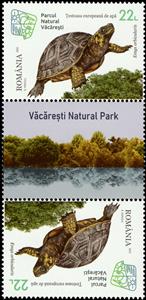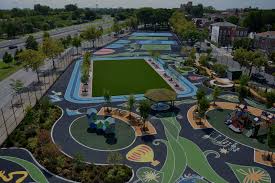Tete-Beche: European Pond Turtle (Emys orbicularis) (Romania 2023)
European Pond Turtle (Emys orbicularis) (Romania 2023)
06 September (Romania ) within release Văcărești Natural Park goes into circulation Tete-Beche European Pond Turtle (Emys orbicularis) face value 2*22 Romanian leu
| Tete-Beche European Pond Turtle (Emys orbicularis) in catalogues | |
|---|---|
| Romfilatelia: | Rom: RO 2434(4)TB2 |
| Colnect codes: | Col: RO 2023.09.06-04d |
Tete-Beche is vertical format.
Tête-bêche pair with English gutterAlso in the issue Văcărești Natural Park:
- Stamp - Common Glider (Neptis sappho) face value 3.50;
- Stamp with Attached Label - Common Glider (Neptis sappho) face value 3.50;
- Tete-Beche - Common Glider (Neptis sappho) face value 2*3.50;
- Gutter Pairs - Common Glider (Neptis sappho) face value 2*3.50;
- Gutter Pairs - Common Glider (Neptis sappho) face value 2*3.50;
- Stamp - Eurasian Otter (Lutra lutra) face value 2.30;
- Stamp with Attached Label - Eurasian Otter (Lutra lutra) face value 2.30;
- Tete-Beche - Eurasian Otter (Lutra lutra) face value 2*2.30;
- Tete-Beche - Eurasian Otter (Lutra lutra) face value 2*2.30;
- Tete-Beche - Eurasian Otter (Lutra lutra) face value 2*2.30;
- Stamp - European Pond Turtle (Emys orbicularis) face value 22;
- Stamp with Attached Label - European Pond Turtle (Emys orbicularis) face value 22;
- Tete-Beche - European Pond Turtle (Emys orbicularis) face value 2*22;
- Tete-Beche - European Pond Turtle (Emys orbicularis) face value 2*22;
- Tete-Beche - European Pond Turtle (Emys orbicularis) face value 2*22;
- Souvenir Sheet - Văcărești Natural Park face value 36.80;
- Stamp - Whiskered Tern (Chlidonias hybrida) face value 9;
- Stamp with Attached Label - Whiskered Tern (Chlidonias hybrida) face value 9;
- Tete-Beche - Whiskered Tern (Chlidonias hybrida) face value 2*9;
- Tete-Beche - Whiskered Tern (Chlidonias hybrida) face value 2*9;
- Tete-Beche - Whiskered Tern (Chlidonias hybrida) face value 2*9;
Tete-Beche European Pond Turtle (Emys orbicularis) it reflects the thematic directions:
Animals are multicellular, eukaryotic organisms of the kingdom Animalia (also called Metazoa). All animals are motile, meaning they can move spontaneously and independently, at some point in their lives. Their body plan eventually becomes fixed as they develop, although some undergo a process of metamorphosis later on in their lives. All animals are heterotrophs: they must ingest other organisms or their products for sustenance.
A park is an area of natural, semi-natural or planted space set aside for human enjoyment and recreation or for the protection of wildlife or natural habitats. Urban parks are green spaces set aside for recreation inside towns and cities. National parks and country parks are green spaces used for recreation in the countryside. State parks and provincial parks are administered by sub-national government states and agencies. Parks may consist of grassy areas, rocks, soil and trees, but may also contain buildings and other artifacts such as monuments, fountains or playground structures. Many parks have fields for playing sports such as baseball and football, and paved areas for games such as basketball. Many parks have trails for walking, biking and other activities. Some parks are built adjacent to bodies of water or watercourses and may comprise a beach or boat dock area. Urban parks often have benches for sitting and may contain picnic tables and barbecue grills.
Reptiles are tetrapod (four-limbed vertebrate) animals in the class Reptilia, comprising today's turtles, crocodilians, snakes, amphisbaenians, lizards, tuatara, and their extinct relatives. The study of these traditional reptile orders, historically combined with that of modern amphibians, is called herpetology. Because some reptiles are more closely related to birds than they are to other reptiles (e.g., crocodiles are more closely related to birds than they are to lizards), the traditional groups of "reptiles" listed above do not together constitute a monophyletic grouping (or clade). For this reason, many modern scientists prefer to consider the birds part of Reptilia as well, thereby making Reptilia a monophyletic class.
Turtles are reptiles of the order Testudines, characterized by a special shell developed mainly from their ribs. Modern turtles are divided into two major groups, the Pleurodira (side necked turtles) and Cryptodira (hidden necked turtles), which differ in the way the head retracts. There are 360 living and recently extinct species of turtles, including land-dwelling tortoises and freshwater terrapins. They are found on most continents, some islands and, in the case of sea turtles, much of the ocean. Like other amniotes (reptiles, birds, and mammals) they breathe air and do not lay eggs underwater, although many species live in or around water.




